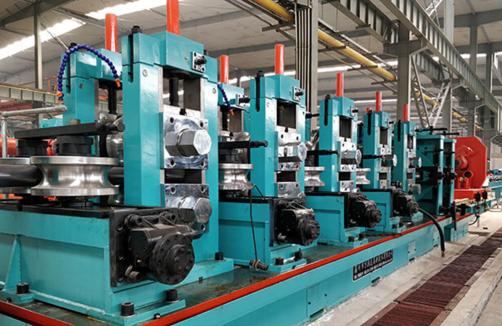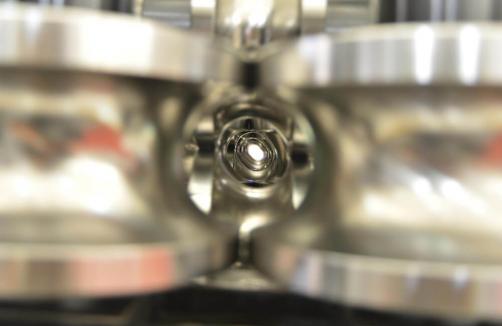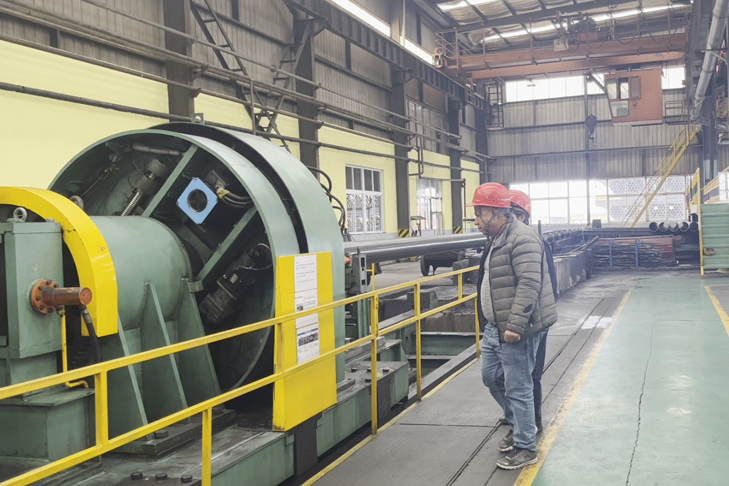Comparison of Hot Saw, Cold Saw, and Milling Saw Technologies and Their Applications
Saws are dynamic cutting systems that use servo-driven tracking technology to synchronize the cutting unit with moving pipes, enabling high-speed continuous cutting. Making ideal for efficient length cutting in welded pipe production lines. Currently, saws are widely used in welded pipe production, accounting for over 80% of applications. There are different kinds of saw type:
Hot Saw
Hot saws use high-speed steel blades (typically 3,000-6,000 RPM) to cut materials by generating heat through friction, reaching temperatures of 800-1,200°C. They are best suited for quickly cutting thick-walled steel pipes (wall thickness >10mm) and high-strength alloy pipes, making them ideal for applications like oil casing pipes and construction scaffolding pipes where speed is critical. However, hot saw cuts often produce burrs and oxidation layers, requiring secondary processing. They also consume more energy (approximately 2.5-3.2 kWh per ton, according to the International Energy Agency's 2022 report). Additionally, blade wear is faster, with an average lifespan of 300-500 cuts per blade (source: MMS *Metal Processing* 2023 industry analysis).
Cold Saw
Cold saws use carbide-tipped blades (200-500 RPM) to perform low-temperature cutting, keeping cut temperatures below 150°C. They achieve high precision (±0.1mm, compliant with ISO 13918 standards) and produce smooth cuts that require no further processing, making them ideal for thin-walled pipes (wall thickness <6mm), stainless steel pipes, and automotive exhaust pipes. Cold saws reduce energy consumption by over 60% compared to hot saws (around 0.8-1.2 kWh per ton) and significantly extend blade life, with each blade lasting for 3,000-5,000 cuts. According to *Metal Processing*'s 2023 market research, cold saws now account for 62% of the precision pipe cutting market, up from 35% in 2015, making them the preferred choice for high-precision applications.
Cold saw is a new on-line cutting technology in the welded pipe industry. The main feature is that it adopts the principle of cold milling. After cutting, the pipe end is flat without burr, and the application with high processing requirements does not need to be cut twice. In addition, because of the servo follow-up fixed length tracking technology, the cutting length accuracy is higher than that of the ordinary flying saw. In the production process, dust and noise pollution are obviously reduced.
Milling Saw
Milling saws use multi-edge cutting heads to perform rotary cutting. Their key advantage is the ability to handle complex cross-section pipes (e.g., square or oval pipes) and ultra-hard materials (e.g., titanium alloys). They achieve cutting precision of ±0.02mm (referencing ASME B94.55 standards) but operate at relatively slower speeds (15-30 m/min).
It is characterized by good cut quality, no burrs, high work efficiency and low noise. The operating system is equipped with a touch screen for easy and convenient operation. The shape and size of the product can be arbitrarily set, cutting parameters can be set, and the operating status and alarm status can be monitored.
Industry Trends and Selection Recommendations
With tightening environmental regulations (e.g., EU CE certification for dust emissions) and growing demand for precision manufacturing, cold saws are rapidly replacing traditional hot saws. The American Society of Mechanical Engineers (ASME) predicts that by 2025, cold saws will account for over 75% of applications in automotive and new energy sectors. Meanwhile, milling saws remain dominant in high-end fields like aerospace and medical devices. For standard construction pipes, hot saws still hold a market share due to cost advantages but require additional post-processing (burr remove) to meet quality standards.
(Note: Data sources include MMS Metal Processing 2023 annual report, ASME technical standards, and International Energy Agency reports.)
Contact WRD
Phone: +86-13752728312 (WhatsApp )
E-mail: info@wrdtubemill.com








